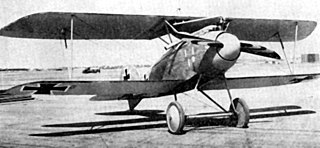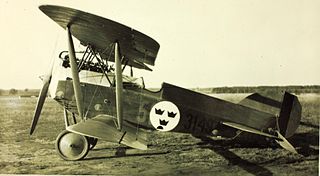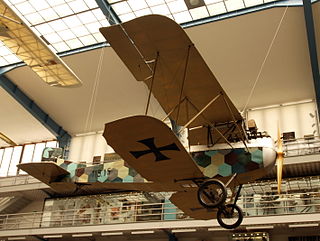Operators

| C.I | |
|---|---|
| Role | Reconnaissance aircraft |
| National origin | Austria-Hungary |
| Manufacturer | Knoller |
| First flight | 1916 |
| Primary user | KuKLFT |
| Number built | 16 |
The Knoller C.I was a reconnaissance aircraft built in Austria-Hungary during World War I for use by the Austro-Hungarian army. It was a conventional biplane design with staggered wings, and seated the pilot and observer in tandem in an open cockpit. The upper wing was swept back.
Production was undertaken at Phönix, but it was built only in small numbers before being supplanted by the Knoller C.II and not all of the examples built were actually flown, with most being placed in storage without engines.
Data from Austro-Hungarian Army Aircraft of World War One, [1] German & Austro-Hungarian aircraft manufacturers 1908–1918 [2]
General characteristics
Performance

The Albatros B.II, was an unarmed German two-seat reconnaissance biplane of the First World War.

The Albatros D.III was a biplane fighter aircraft used by the Imperial German Army Air Service (Luftstreitkräfte) during World War I. A modified licence model was built by Oeffag for the Austro-Hungarian Air Service (Luftfahrtruppen). The D.III was flown by many top German aces, including Wilhelm Frankl, Erich Löwenhardt, Manfred von Richthofen, Karl Emil Schäfer, Ernst Udet, and Kurt Wolff, and Austro-Hungarian ones, like Godwin von Brumowski. It was the preeminent fighter during the period of German aerial dominance known as "Bloody April" 1917.

The Albatros B.I, was a German military reconnaissance aircraft designed in 1913 and which saw service during World War I.

The Hansa-Brandenburg C.I, also known as Type LDD, was a 2-seater armed single-engine reconnaissance biplane designed by Ernst Heinkel, who worked at that time for the parent company in Germany. The C.I had similarities with the earlier B.I, including inward-sloping interplane bracing struts. Like other early-war Austro-Hungarian reconnaissance aircraft, such as C-types of Lloyd or Lohner, the Type LDD had a communal cockpit for its crew.

The Hansa-Brandenburg D.I, also known as the KD was a German fighter aircraft of World War I. Despite poor handling characteristics it was put into service by Austria-Hungary, where some aircraft served until the end of the war.

The Phönix D.I, with the D.II and D.III variants, was an Austro-Hungarian First World War biplane fighter built by the Phönix Flugzeug-Werke and based on the Hansa-Brandenburg D.I.

The Knoller C.II was a reconnaissance aircraft built in Austria-Hungary during World War I for use by the Austro-Hungarian army. It was a conventional biplane design with staggered wings, and seated the pilot and observer in tandem in an open cockpit. Like Knoller's preceding C.I design, the upper wing was swept back, but not as far as it had been on the earlier aircraft. The structure was wooden throughout, with the wings skinned in fabric and the fuselage in plywood. The interplane struts were made of steel and arranged in a warren truss configuration.

The Lloyd C.II and its derivatives, the C.III and C.IV were reconnaissance aircraft produced in Austria-Hungary during the First World War. They were based on the Lloyd company's pre-war C.I design, and like it, were conventional biplanes with swept-back wings.
The Aviatik C.I, the prototypes of which were known as Aviatik 30.14, Aviatik 30.15 and Aviatik 30.16, was an Austro-Hungarian 2-seat reconnaissance aircraft produced from 1917.(Note: the is not part of the designation, but used to disambiguate from the German-built Aviatik aircraft with the same designation.)

The Phönix C.I, given serial numbers in the Phönix 121 range, was an Austro-Hungarian First World War reconnaissance and general-purpose Biplane built by Phönix and Lloyd.
The Ufag 60.03, prototype for proposed production as the Ufag C.II, was a reconnaissance aircraft of the Austro-Hungarian air forces (Luftstreitskrafte), in the First World War. The C.II fared well in the 1918 C-class trials and production was planned but abandoned with the armistice in November 1918. The sole Ufag 60.03 was offered for sale to the Czecho-Slovakian government in 1920.

The UFAG C.I was a military reconnaissance aircraft produced in the Austro-Hungarian Empire during World War I, by the Ungarische Flugzeugfabrik Abteil Gesellschaft (UFAG). It was introduced in April 1918, and was widely used on the Italian Front in the final months of World War I.
The Halberstadt C.III was a German single-engined reconnaissance biplane of World War I, built by Halberstädter Flugzeugwerke.
The Germania C.I was a prototype two-seat general-purpose biplane built by Halberstadt during World War I.
The Halberstadt C.VII was a German single-engined reconnaissance biplane of World War I, built by Halberstädter Flugzeugwerke. It was derived from the Halberstadt C.V, with a more powerful supercharged 183 kW (245 hp) Maybach Mb.IV engine.
The Halberstadt C.IX was a German single-engined reconnaissance biplane of World War I, built by Halberstädter Flugzeugwerke. It was derived from the Halberstadt C.V, with a more powerful supercharged 230 hp Hiero engine.
The Halberstadt C.VIII was a prototype two-seat general-purpose biplane built by Halberstadt during World War I.
The Knoller D.I series 70 was a prototype fighter aircraft built in thee Austro-Hungarian Empire during World War I for use by the Kaiserliche und Königliche Luftfahrtruppen (KuKLFT).
The Hansa-Brandenburg C.II, company designation K,, was a two-seat reconnaissance aircraft built in Germany by Hansa-Brandenburg in World War I, powered by Mercedes D.III or Hiero 6 water-cooled in-line piston engines.
The Phönix 20.24 was a prototype German fighter plane built in the last months of World War I.